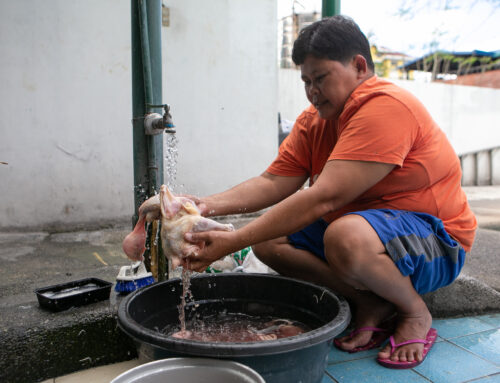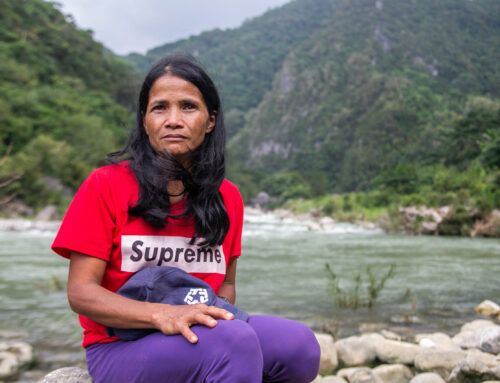“Beijing needs to stop allowing obnoxious overseas investments through its state corporations, industries and banks. It must step in and re-orient its investment policies towards the global climate goal and complement and hasten the environmental policy objectives of host countries, while proactively reaching out to, and listening to, civil society groups.
Only Clean and Green Belt and Road are Acceptable in the Philippines
by Ian Rivera, National Coordinator, Philippine Movement for Climate Justice (PMCJ)
Photo by Gigie Cruz
With an amiable diplomatic stance with the Beijing government, the Philippine’s Duterte government has successfully ushered in Chinese investment under the BRI despite strong concern, and alarm, within significant sectors in the Philippines.
There are now fifty-two projects in the Philippines that are funded by China. Their total investment reaches $19.8 billion USD, while in comparison, the 2019 Philippine National Budget only stands at $70.5 billion USD. Three of the projects are now on-going, while eighteen are in the pipeline, and the other thirty-one are undergoing evaluation. Most of the projects, such as roads, bridges, railways, irrigation and dams, have value chains in the extractives, with raw materials expected to come from no other place but the already fragile Philippine ecosystem.
The Philippine government does not have a solid record of transparent and thorough environmental and social impact assessments, clearly illustrated by the testimonials given by the affected communities and civil society groups in the Kaliwa Dam Project. If the Chinese government gives the green light to the remaining forty-nine projects without exercising due diligence on its part, this will not only pose an environmental and social nightmare to the Philippines and its people but also long-term financial and reputational risks to China.
Besides infrastructure projects, China’s investment is also entering existing operational coal power plants in the Philippines. The Global Environment Institute reported that China is funding a total of 4.3 gigawatts of coal power in the country, despite the commitments both China and the Philippines have made in the Paris Agreement to cut dependence on fossil fuels and to shift finance flows away from such dirty fuels.
It is ironic to note the Philippine Government is still pursuing the expansion of coal plants in the Philippines despite the costly devastations these climate impacts have caused. The Philippines ranks third globally in terms of climate vulnerability and risks, and devastations have already affected the country’s economic growth for the past two decades. The Philippine people, who are witnessing rising sea level every day while still recovering from Haiyan’s aftermath in 2008, are saying “no” to coal, loud and clear.
In the past five years, the Philippine Movement for Climate Justice (PMCJ) has successfully stopped, through campaigns and legal actions, nine coal plants with a combined capacity of 9.6 gigawatts and stalled another seven with a combined 3.55 gigawatts from completing their application requirements. The movement is also suing international investors, including the International Finance Corporation of the World Bank, and the International Monetary Fund, for funding the expansion of coal in our country, a total of 19 coal plants all-in-all. With such strong signals trickling down the investment line, some local banks are already moving away from further investing in coal projects. Local communities, churches and environmental groups are strongly against coal. Areas like Lanao del Norte Province, Cebu Province, Quezon Province and Bataan Province, where the planned Chinese-funded coal power plants are located, have strong resistance against coal plants.
If China is not seeing the financial risks or hearing the public opposition voices, it is likely because the Department of Energy of the Philippines is providing China with faulty information, resulting in bad publicity for China that can easily worsen due to the disputes over the West Philippine Sea (South China Sea). Public opinion in the country regarding China is at an all-time low. Philippine think tanks, media, and policy groups, still see China as a bully in West Philippine Sea; the self-centered ‘Middle Kingdom’ with generous loans but little mindfulness of the sovereignty of host countries. Any news dragging China into controversy in the Philippines immediately goes to the front page for the Philippine media.
Beijing needs to stop allowing obnoxious overseas investments through its state corporations, industries and banks. It must step in and re-orient its investment policies towards the global climate goal and complement and hasten the environmental policy objectives of host countries, while proactively reaching out to, and listening to, civil society groups.
The Philippines need investment, particularly in energy development. Almost a quarter of the 102 million Philippine people do not have electricity, while the rest are paying the second-highest electricity bills in Asia, right after Japan, where per capita income is almost 5 times that of the Philippines. China is the world’s largest renewable energy investor and producer and is moving fast to reduce the proportion of coal in its energy mix. While China is becoming greener, with more trees, providing electricity access to almost all villages, and building an “ecological civilization”, other countries, such as the Philippines, can also benefit from these. Through experience sharing and overseas investments that “adhere to the concept of openness, greenness and cleanliness,” as President Xi pledged at the Second Belt and Road Summit in April 2019, China can show the way what its western counterparts have failed.




